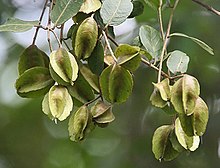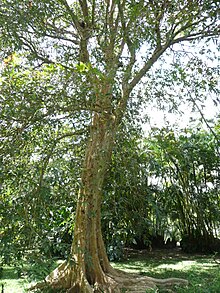Terminalia arjunais a tree of thegenusTerminalia.It is commonly known asarjuna[1]orarjun treein English.[2]
| Terminalia arjuna | |
|---|---|

| |
| Arjuna fruit | |

| |
| Arjuna flowers with aSykes's warbler | |
| Scientific classification | |
| Kingdom: | Plantae |
| Clade: | Tracheophytes |
| Clade: | Angiosperms |
| Clade: | Eudicots |
| Clade: | Rosids |
| Order: | Myrtales |
| Family: | Combretaceae |
| Genus: | Terminalia |
| Species: | T. arjuna
|
| Binomial name | |
| Terminalia arjuna (Roxb.) Wight & Arn.
| |


Description
editT. arjunagrows to about 20–25 metres tall; usually has abuttressedtrunk, and forms a wide canopy at the crown, from which branches drop downwards. It has oblong, conical leaves which are green on the top and brown below; smooth, grey bark; it has pale yellow flowers which appear between March and June; its glabrous, 2.5 to 5 cm fibrous woody fruit, divided into five wings, appears between September and November.[1][2]
The tree does not suffer from any major diseases or pests, but it is susceptible toPhyllactinia terminaleand rot due topolystictus affinis.[3]
Distribution and habitat
editThe arjuna is seen across theIndian Subcontinent,and usually found growing on river banks or near dry river beds inUttar Pradesh,Bihar,Maharashtra,Madhya Pradesh,West Bengal,Odishaand south and centralIndia,KarachiPakistanalong withSri LankaandBangladesh.[1][4]It has also been planted inMalaysia,IndonesiaandKenya.[3]
Importance
editSilk production
editThe arjuna is one of the species whose leaves are fed on by theAntheraea paphiamoth which produces thetassar silk,awild silkof commercial importance.[5]
Gallery
edit-
Terminalia arjuna
-
Terminalia arjunamiddle trunk
-
Terminalia arjunaleaves
-
Inflorescence ofTerminalia arjuna
-
Pollen grains ofTerminalia arjuna
-
Arjuna fruits (dried)
-
Terminalia arjunainBagh-e-Jinnah, Lahore
-
The bark of Terminalia arjuna (অর্জুন) is found in Bana Bitan, Kolkata, West Bengal, India
References
edit- ^abcBiswas, Moulisha; Biswas, Kaushik; Karan, Tarun K; Bhattacharya, Sanjib; Ghosh, Ashoke K; Haldar, Pallab K (2011)."Evaluation of analgesic and anti-inflammatory activities ofTerminalia arjunaleaf ".Journal of Phytology.3(1): 33–8.
- ^ab"Arjun Tree".Eco India.
- ^abThe CABI Encyclopedia of Forest Trees.2013. p. 464.ISBN9781780642369.
- ^Rastogī, Rekhā (2008).Let Us Identify The Useful Trees(New).Children's Book Trust. p. 7,8.ISBN978-81-7011-919-7.
- ^M.P. Shiva."Non-wood forest products In 15 countries of Tropical Asia".Food and Agriculture Organization of the United Nations.
- Media related toTerminalia arjunaat Wikimedia Commons
- Data related toTerminalia arjunaat Wikispecies